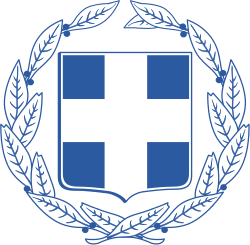Orders, decorations, and medals of Greece
The Greek honors system goes back to 1829 and the establishment of the Order of the Redeemer at the Fourth National Assembly at Argos. However, the relevant decree was signed in Nafplio by King Otto on May 20, 1833. The Grand Cross of the Order of the Redeemer remains the highest honor of Greece to this day.
Hellenic Republic
Orders
-
 Order of the Redeemer
Order of the Redeemer -
 Order of Honour
Order of Honour -
 Order of the Phoenix
Order of the Phoenix -
 Order of Beneficence (restricted to females)
Order of Beneficence (restricted to females)
Gallantry and merit medals
-
 Medal for Gallantry
Medal for Gallantry -
 Cross of Valour
Cross of Valour -
 War Cross
War Cross - Medal for Outstanding Acts
- Medal for Exceptional Acts
-
 Medal of Military Merit
Medal of Military Merit - Air Force Cross
- Gendarmerie War Cross
- Medal of Police Merit
Commemorative and campaign medals
- Cross for the War of Independence 1821–29
- Cross for the Bavarian Auxiliary Corps
- Medal for the Proclamation of the Constitution of 1843
- Medal for the Greco-Turkish War of 1912–13
- Medal for the Greco-Bulgarian War
- Medal for the Macedonian Struggle
- Inter-Allied Victory Medal (1916–18)
- Royal Hellenic Navy Campaign Cross
- Maritime War Cross
- Medal for the War of 1940–1941
- Medal for the War of 1941–1945
- Medal for the National Resistance (1941–45)
- United Nations Korea Medal
- Centenary Memorial Medal of the Greek Royal Family
- Medal of Military Worth
- Flying Cross
- Air Force Merit Cross
- Medal for Operations in Cyprus (1964, 1967, 1974)
- Commendation Medal for Merit and Honour
- Commendation Medal for Long Term Service
- Commendation Medal for Participation in a Peacekeeping Mission
Kingdom of Greece
-
 Order of the Redeemer
Order of the Redeemer -
 Order of St. George and Constantine (dynastic)
Order of St. George and Constantine (dynastic) -
 Order of St. Olga and Sophia (dynastic)
Order of St. Olga and Sophia (dynastic) -
 Order of George I (dynastic)
Order of George I (dynastic) -
 Order of the Phoenix
Order of the Phoenix -
 Order of Beneficence
Order of Beneficence
Ranks
As with most European orders, the Greek orders have the following ranks, in order of precedence:
- Grand Cross
- Grand Officer
- Commander
- Knight of the Gold Cross
- Knight of the Silver Cross
Transmission of honors
In the past, the insignia of the order were to be returned to the State. However, in recent years, the rule has changed and the heirs of the honoree may keep the insignia.
Grand Master
The Grand Master of the Greek orders is the head of state of the country. Since 1975, Greece is a republic and the head of state is the President of Greece who is also responsible for awarding them, according to article 46, paragraph 2 of the Constitution of Greece and law 106/1975,[1] upon the recommendation of the Minister for Foreign Affairs.
Selection criteria
According to Law 106/1975, all proposals made by the Minister for Foreign Affairs are reviewed by the Council on Honors (Greek: Συμβούλιο Ταγμάτων Αριστείας) when it applies to Greek citizens, the Greek diaspora, military officers, and government workers. Individuals are selected to reward their contributions to Greece either it be the state, its culture, sports, arts, language, etc.
The Council on Honors, which comes together by decision of the Minister for Foreign Affairs, serves for a two-year term:[1]
- the President of the Council of State
- the President of the Court of Cassation
- two Greek citizens who have been awarded the Grand Cross
- one of the senior most diplomats of the Ministry of Foreign Affairs, either an ambassador or deputy minister
- a senior military officer, set by the Defence General Staff
- a representative from the office of the President of Greece
Honorees
Those that have been honored by one of the Greek State Orders are given the right to wear their insignia for life, provided they have not been stricken from the rolls of their respective order, as per the penal code or by decision of the Council on Honors. The latter group may take such a decision if it deems that the person retaining the honor causes public discomfort or negatively affects the prestige of the Order. After the death of the honoree, the insignia may be kept by his or her heirs.[1]
References
- 1 2 3 Law 106/1975 of the Hellenic Republic
| Wikimedia Commons has media related to Orders, decorations and medals of Greece. |
| Greek orders timeline | ||||||||||||||||||||||||||||||||||||||||||||||||||||||||||||||||||||||
|---|---|---|---|---|---|---|---|---|---|---|---|---|---|---|---|---|---|---|---|---|---|---|---|---|---|---|---|---|---|---|---|---|---|---|---|---|---|---|---|---|---|---|---|---|---|---|---|---|---|---|---|---|---|---|---|---|---|---|---|---|---|---|---|---|---|---|---|---|---|---|
| Orders by precedence | 1832- 1909 |
1910s | 1920s | 1930s | 1940s | 1950s | 1960s | 1970-present | ||||||||||||||||||||||||||||||||||||||||||||||||||||||||||||||
| O. of the Redeemer | . | Rep. | ||||||||||||||||||||||||||||||||||||||||||||||||||||||||||||||||||||
| Order of Honour | Rep. | |||||||||||||||||||||||||||||||||||||||||||||||||||||||||||||||||||||
| O. of St George & Constantine | . | . | . | Dynastic | ||||||||||||||||||||||||||||||||||||||||||||||||||||||||||||||||||
| O. of St Olga & Sophia | . | . | . | Dynastic | ||||||||||||||||||||||||||||||||||||||||||||||||||||||||||||||||||
| Order of George I | . | . | . | . | Dynastic | |||||||||||||||||||||||||||||||||||||||||||||||||||||||||||||||||
| O. of the Phoenix | . | Rep. | ||||||||||||||||||||||||||||||||||||||||||||||||||||||||||||||||||||
| O. of Beneficence | . | Rep. | ||||||||||||||||||||||||||||||||||||||||||||||||||||||||||||||||||||
| Years | ||||||||||||||||||||||||||||||||||||||||||||||||||||||||||||||||||||||
| Regime | Monarchy | Republic | Mon. | Rep. | Monarchy | Rep. | ||||||||||||||||||||||||||||||||||||||||||||||||||||||||||||||||
| 1832- 1909 |
1910s | 1920s | 1930s | 1940s | 1950s | 1960s | 1970-present | |||||||||||||||||||||||||||||||||||||||||||||||||||||||||||||||
